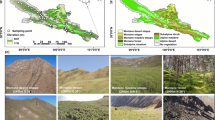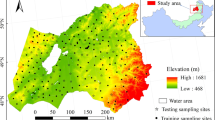Abstract
Soil organic carbon (SOC) has been assessed in three dimension (3D) in several studies, but little is known about the combined effects of land use and soil depth on SOC stocks in semi-arid areas. This paper investigates the 3D distribution of SOC to a depth of 1 m in a 4600-ha area in southeastern Iran with different land uses under the irrigated farming (IF), dry farming (DF), orchards (Or), range plants on the Gachsaran formation (RaG), and range plants on a quaternary formation (RaQ). Predictions were made using the artificial neural networks (ANNs), regression trees (RTs), and spline functions with auxiliary covariates derived from a digital elevation model (DEM), the Landsat 8 imagery, and land use types. Correlation analysis showed that the main predictors for SOC in the topsoil were covariates derived from the imagery; however, for the lower depths, covariates derived from both the DEM and imagery were important. ANNs showed more efficiency than did RTs in predicting SOC. The results showed that 3D distribution of SOC was significantly affected by land use types. SOC stocks of soils under Or and IF were significantly higher than those under DF, RaG, and RaQ. The SOC below 30 cm accounted for about 59% of the total soil stock. Results showed that depth functions combined with digital soil mapping techniques provide a promising approach to evaluate 3D SOC distribution under different land uses in semi-arid regions and could be used to assess changes in time to determine appropriate management strategies.










Similar content being viewed by others
References
Alpaydin, E. (2010). Introduction to machine learning (Second ed.). Cambridge, MA, U.S.A.: MIT Press.
Andronikov, V. L., & Dobrovol’skiy, G. V. (1991). Modern problems in the study of soils from space imagery. Mapping Sciences and Remote Sensing, 28(2), 92–101.
Baker, L., & Ellison, D. (2008). Optimization of pedotransfer functions using an artificial neural network ensemble method. Geoderma, 144(1–2), 212–224.
Batjes, N. H. (1996). Total carbon and nitrogen in the soils of the world. European Journal of Soil Science, 47, 151–163.
Beckett, P. H. T., & Webster, R. (1971). Soil variability: a review. Soils and Fertilizers, 34, 1–15.
Ben-Dor, E., Taylor, R. G., Hill, J., Dematte, J. A. M., Whiting, M. L., Chabrillat, S., & Sommer, S. (2008). Imaging spectrometry for soil applications. Advances in Agronomy, 97, 321–392.
Bishop, T. F. A., McBratney, A. B., & Laslett, G. M. (1999). Modelling soil attribute depth functions with equal-area quadratic smoothing splines. Geoderma, 91(1–2), 27–45.
Bou Kheir, R., Greve, M. H., Bøcher, P. K., Greve, M. B., Larsen, R., & McCloy, K. (2010). Predictive mapping of soil organic carbon in wet cultivated lands using classification-tree based models: the case study of Denmark. Journal of Environmental Management, 91, 1150–1160.
Brus, D. J., Kempen, B., & Heuvelink, G. B. M. (2011). Sampling for validation of digital soil maps. European Journal of Soil Science, 62(3), 394–407.
Campbell, N. A., Mulcahy, M. J., & McArthur, W. M. (1970). Numerical classification of soil profiles on the basis of field morphological properties. Australian Journal of Soil Research, 8, 43–58.
Colwell, J. D. (1970). A statistical–chemical characterization of four great soil groups in southern new South Wales based on orthogonal polynomials. Australian Journal of Soil Research, 8, 221–238.
Duncan, D. B. (1955). Multiple Range and Multiple F Tests. Biometrics, 11(1):1
Fiener, P., Gottfried, T., Sommer, M., & Steger, K. (2014). Soil organic carbon patterns under different land uses in South India. Geoderma Regional, 2-3, 91–101.
Florinsky, I. V., Eilers, R. G., Manning, G. R., & Fuller, L. G. (2002). Prediction of soil properties by digital terrain modelling. Environmental Modelling & Software, 17, 295–311.
GlobalSoilMap (2011). Specifications, version 1 GlobalSoilMap.net products. Release 2.1.
Grace, J. (2004). Understanding and managing the global carbon cycle. Journal of Ecology, 92, 189–202.
Guo, P. T., Liu, H. B., & Wu, W. (2009). Spatial prediction of soil organic matter using terrain attributes in a hilly area. International Conference on Environmental Science and Information Application Technology (pp. 759–762) Wuhan: ESIAT.
Jackson, J. E. (1991). A user’s guide to principal components. New York: John Wiley & Sons.
Jenny, H. (1941). Factors of soil formation: a system of quantitative pedology. New York: McGrawHill.
Johnston, C. A., Groffman, P., Breshears, D. D., Cardon, Z. G., Currie, W., Emanuel, W., et al. (2004). Carbon cycling in soil. Frontiers in Ecology and the Environment, 2, 522–528.
Kempen, B., Brus, D. J., & Stoorvogel, J. J. (2011). Three-dimensional mapping of soil organic matter content using soil type–specific depth functions. Geoderma, 162(1–2), 107–123.
Lacoste, M., Minasny, B., McBratney, A. B., Michot, D., Viaud, V., & Walter, C. (2014). High resolution 3D mapping of soil organic carbon in a heterogeneous agricultural landscape. Geoderma, 213, 296–311.
Li, M., Zhang, X., Pang, G., & Han, F. (2013). The estimation of soil organic carbon distribution and storage in a small catchment area of the loess plateau. Catena, 101, 11–16.
Li, Z., Liu, C., Dong, Y., Chang, X., Nie, X., Liu, L., et al. (2017). Response of soil organic carbon and nitrogen stocks to soil erosion and land use types in the loess hilly–gully region of China. Soil and Tillage Research, 166, 1–9.
Liu, F., Zhang, G. L., Sun, Y. J., Zhao, Y. G., & Li, D. C. (2013). Mapping the three-dimensional distribution of soil organic matter across a subtropical hilly landscape. Soil Science Society of America Journal, 77(4), 1241–1253.
Loh, W. Y. (2011). Classification and regression tree. WIREs Data Mining and Knowl Discov., 1(1), 14–23.
Malone, B. P., McBratney, A. B., Minasny, B., & Laslett, G. M. (2009). Mapping continuous depth functions of soil carbon storage and available water capacity. Geoderma, 154(1–2), 138–152.
Marinho, M. A., Pereira, M. W. M., Vázquez, E. V., Lado, M., & González, A. P. (2017). Depth distribution of soil organic carbon in an Oxisol under different land uses: stratification indices and multifractal analysis. Geoderma, 287, 126–134.
McBratney, A. B., Mendonça-Santos, M. L., & Minasny, B. (2003). On digital soil mapping. Geoderma, 117(1–2), 3–52.
Meersmans, J., Van Wesemael, B., De Ridder, F., Fallas Dotti, M., De Baets, S., & Van Molle, M. (2009). Changes in organic carbon distribution with depth in agricultural soils in northern Belgium, 1960–2006. Global Change Biology, 15, 2739–2750.
Metternicht, G. I., & Zinck, J. A. (2003). Remote sensing of soil salinity: potentials and constraints. Remote Sensing of Environment, 85(1), 1–20.
Minasny, B., & McBratney, A. B. (2006). A conditioned Latin hypercube method for sampling in the presence of ancillary information. Computers & Geosciences, 32, 1378–1388.
Minasny, B., McBratney, A. B., Mendonca-Santos, M. L., Odeh, I. O. A., & Guyon, B. (2006). Prediction and digital mapping of soil carbon storage in the lower Namoi Valley. Australian Journal of Soil Research, 44(3), 233–244.
Minasny, B., McBratney, A. B., Malone, B. P., & Wheeler, I. (2013). Digital mapping of soil carbon. Advances in Agronomy, 118, 1–47.
Mishra, U., Lal, R., Slater, B., Calhoun, F., Liu, D., & Van Meirvenne, M. (2009). Predicting soil organic carbon stock using profile depth distribution functions and ordinary kriging. Soil Science Society of America Journal, 73(2), 614–621.
Mishra, U., Lal, R., Liu, D. S., & Van Meirvenne, M. (2010). Predicting the spatial variation of the soil organic carbon pool at a regional scale. Soil Science Society of America Journal, 74, 906–914.
Mulder, V. L., de Bruin, S., Schaepman, M. E., & Mayr, T. R. (2011). The use of remote sensing in soil and terrain mapping—a review. Geoderma, 162, 1–19.
Nelson, D. W., & Sommer, L. E. (1982). Total carbon, organic carbon, and organic matter. In A. L. Page (Ed.), Methods of soil analysis, Part2 (pp. 539–579). Madison: American Society of Agronomy.
Nyssen, J., Tmesgen, H., Lemenih, M., Zenebe, A., Haregeweyn, N., & Haile, M. (2008). Spatial and temporal variation of soil organic carbon stocks in a lake retreat area of the Ethiopian Rift Valley. Geoderma, 146(1–2), 261–268.
Orton, T. G., Pringle, M. J., Page, K. L., Dalal, R. C., & Bishop, T. F. A. (2014). Spatial prediction of soil organic carbon stock using a linear model of coregionalisation. Geoderma, 230–231, 119–130.
Ponce-Hernandez, R., Marriott, F. H. C., & Beckett, P. H. T. (1986). An improved method for reconstructing a soil profile from analysis of a small number of samples. Journal of Soil Science, 37(3), 455–467.
Rumpel, C., & Köegel-Knabner, I. (2011). Deep soil organic matter—a key but poorly understood component of terrestrial C cycle. Plant and Soil, 338, 143–158.
Simbahan, G. C., Dobermann, A., Goovaerts, P., Ping, J., & Haddix, M. L. (2006). Fine resolution mapping of soil organic carbon based on multivariate secondary data. Geoderma, 132, 471–489.
Slaymaker, O. (2001). The role of remote sensing in geomorphology and terrain analysis in the Canadian cordillera. International Journal of Applied Earth Observation and Geoinformation, 3, 11–17.
Soil Survey Staff. (2014). Keys to soil taxonomy. Washington: USDA-NRCS.
Sreekanth, P. D., Sreedevi, P. D., Ahmed, S., & Geethanjali, N. (2011). Comparison of FFNN and ANFIS models for estimating groundwater level. Environmental Earth Sciences, 62(6), 1301–1310.
Stevens, A., Udelhoven, T., Denis, A., Tychon, B., Lioy, R., Hoffmann, L., & van Wesemael, B. (2010). Measuring soil organic carbon in croplands at regional scale using airborne imaging spectroscopy. Geoderma, 158, 32–45.
Stoorvogel, J. J., Kempen, B., Heuvelink, G. B. M., & de Bruin, S. (2009). Implementation and evaluation of existing knowledge for digital soil mapping in Senegal. Geoderma, 149(1–2), 161–170.
Taghizadeh-Mehrjardi, R., Minasny, B., Sarmadian, F., & Malone, P. B. (2014a). Digital mapping of soil salinity in Ardakan region, Central Iran. Geoderma, 213(1), 15–28.
Taghizadeh-Mehrjardi, R., Amirin Chakan, A., & Sarmadian, F. (2014b). 3D digital mapping of soil cation exchange capacity in Dorud, Lorestan province. Journal of Water and Soil, 28(5), 998–1010 (in Farsi).
Taghizadeh-Mehrjardi, R., Nabiollahi, K., & Kerry, R. (2016a). Digital mapping of soil organic carbon at multiple depths using different data mining techniques in Baneh region, Iran. Geoderma, 266, 98–110.
Taghizadeh-Mehrjardi, R., Toomanian, N., Khavaninzade, A. R., Jafari, A., & Triantafilis, J. (2016b). Predicting and mapping of soil particle-size fractions with adaptive neuro-fuzzy inference and ant colony optimization in Central Iran. European Journal of Soil Science, 67(6), 707–725.
Umali, B. P., Oliver, D. P., Forrester, S., Chittleborough, D. J., Hutson, J. L., Kookana, R. S., & Ostendorf, B. (2012). The effect of terrain and management on the spatial variability of soil properties in an apple orchard. Catena, 93, 38–48.
Vaysse, K., & Lagacherie, P. (2015). Evaluating digital soil mapping approaches for mapping GlobalSoilMap soil properties from legacy data in Languedoc Roussillon (France). Geoderma Regional, 4(1), 20–30.
Zhang, S., Huang, Y., Shen, C., Ye, H., & Du, Y. (2012). Spatial prediction of soil organic matter using terrain indices and categorical variables as auxiliary information. Geoderma, 171-172, 35–43.
Xin, Z., Qin, Y., & Yu, X. (2016). Spatial variability in soil organic carbon and its influencing factors in a hilly watershed of the loess plateau, China. Catena, 137, 660–669.
Acknowledgements
This study was funded by Behbahan Khatam Alanbia University of Technology. The authors also thank the editor and reviewers for helpful reviews of the manuscript.
Author information
Authors and Affiliations
Corresponding author
Rights and permissions
About this article
Cite this article
Amirian Chakan, A., Taghizadeh-Mehrjardi, R., Kerry, R. et al. Spatial 3D distribution of soil organic carbon under different land use types. Environ Monit Assess 189, 131 (2017). https://doi.org/10.1007/s10661-017-5830-9
Received:
Accepted:
Published:
DOI: https://doi.org/10.1007/s10661-017-5830-9




